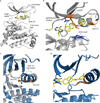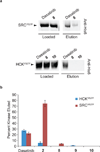Active site profiling reveals coupling between domains in SRC-family kinases
- PMID: 23143416
- PMCID: PMC3522794
- DOI: 10.1038/nchembio.1118
Active site profiling reveals coupling between domains in SRC-family kinases
Abstract
Protein kinases, key regulators of intracellular signal transduction, have emerged as an important class of drug targets. Chemical proteomic tools that facilitate the functional interrogation of protein kinase active sites are powerful reagents for studying the regulation of this large enzyme family and performing inhibitor selectivity screens. Here we describe a new crosslinking strategy that enables rapid and quantitative profiling of protein kinase active sites in lysates and live cells. Applying this methodology to the SRC-family kinases (SFKs) SRC and HCK led to the identification of a series of conformation-specific, ATP-competitive inhibitors that have a distinct preference for the autoinhibited forms of these kinases. Furthermore, we show that ligands that have this selectivity are able to modulate the ability of the regulatory domains of SRC and HCK to engage in intermolecular binding interactions. These studies provide insight into the regulation of this important family of tyrosine kinases.
Figures






References
-
- Manning G, Whyte DB, Martinez R, Hunter T, Sudarsanam S. The protein kinase complement of the human genome. Science. 2002;298:1912–1934. - PubMed
-
- Cohen P. Protein kinases – the major drug targets of the twenty-first century? Nat. Rev. Drug Discovery. 2002;1:309–315. - PubMed
-
- Zhang J, Yang PL, Gray NS. Targeting cancer with small molecule kinase inhibitors. Nat. Rev. Cancer. 2009;9:28–39. - PubMed
-
- Cravatt BF, Wright AT, Kozarich JW. Activity-based protein profiling: from enzyme chemistry to proteomic chemistry. Annu. Rev. Biochem. 2008;77:383–313. - PubMed
-
- Barglow KT, Cravatt BF. Activity-based protein profiling for the functional annotation of enzymes. Nat. Methods. 2007;4:822–827. - PubMed
Publication types
MeSH terms
Substances
Associated data
- PubChem-Substance/152146113
- PubChem-Substance/152146114
- PubChem-Substance/152146115
- PubChem-Substance/152146116
- PubChem-Substance/152146117
- PubChem-Substance/152146118
- PubChem-Substance/152146119
- PubChem-Substance/152146120
- PubChem-Substance/152146121
- PubChem-Substance/152146122
- PubChem-Substance/152146123
- PubChem-Substance/152146124
- PubChem-Substance/152146125
- PubChem-Substance/152146126
Grants and funding
LinkOut - more resources
Full Text Sources
Other Literature Sources
Miscellaneous

